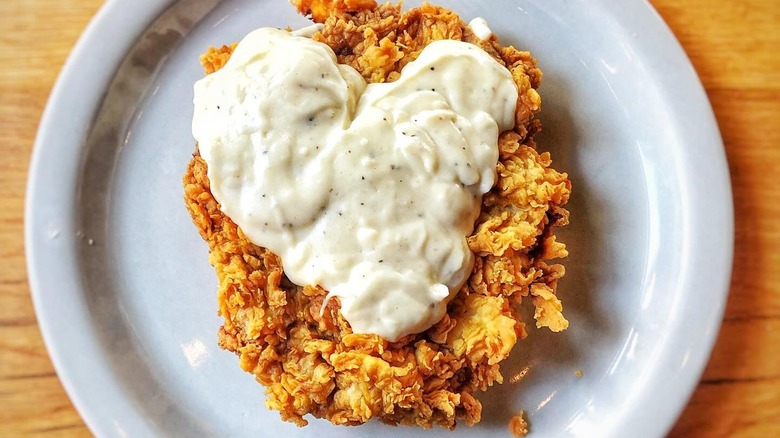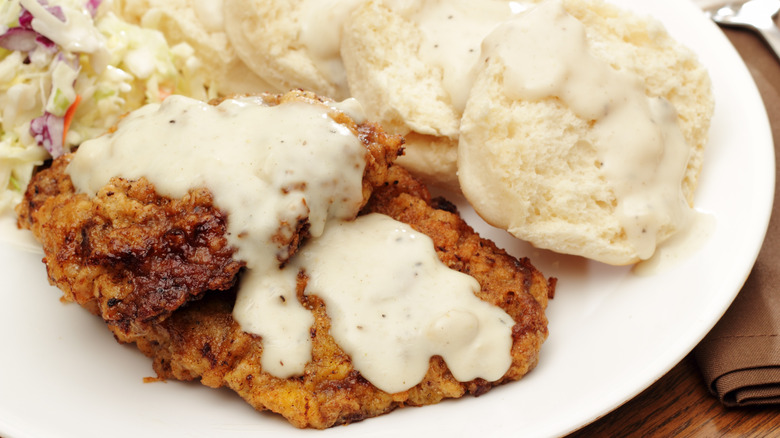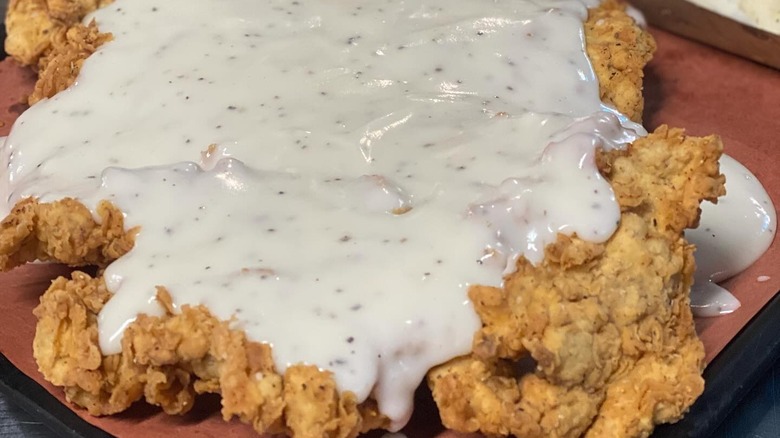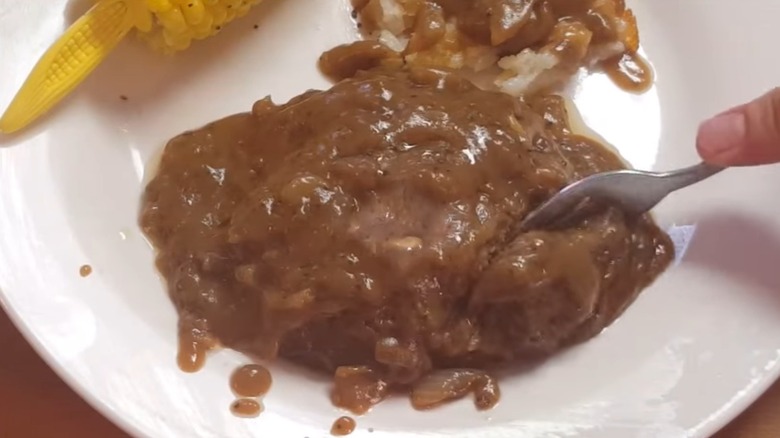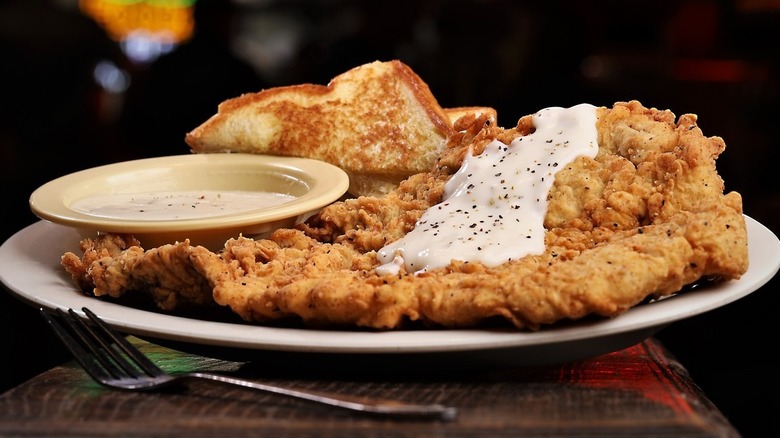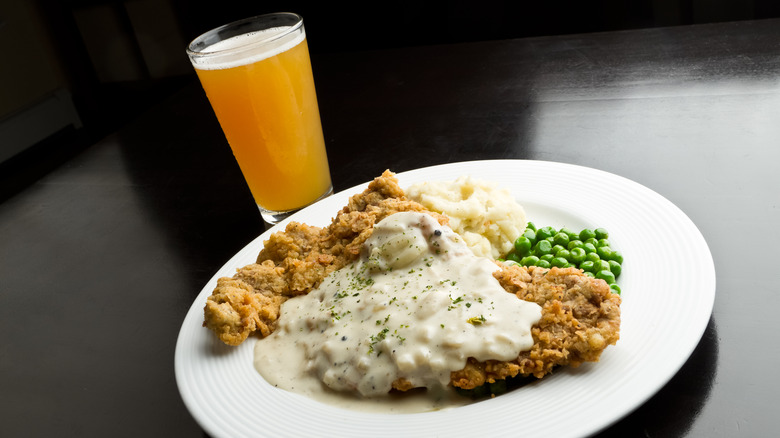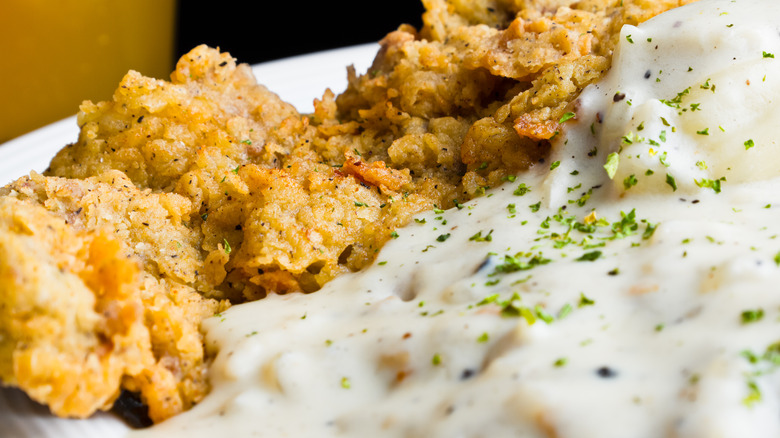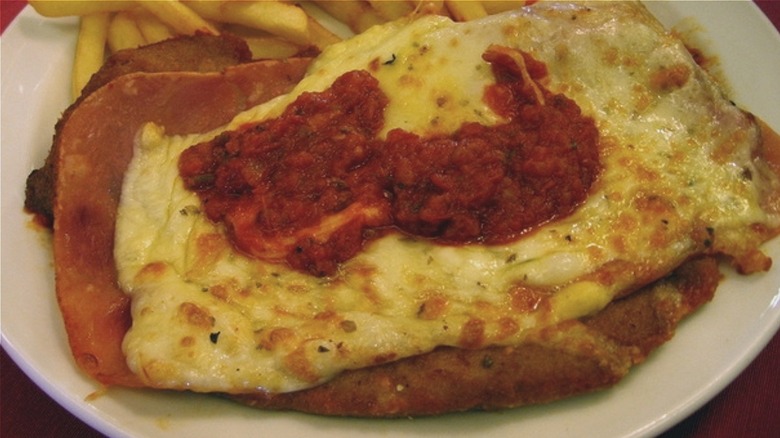Everything You Need To Know About Chicken Fried Steak
Chicken fried steak isn't chicken, nor is it steak as one might normally expect. This dish — considered one of 14 Texas foods you need to try before you die — consists of a tough piece of beef that's tenderized, dusted in flour, and then fried on a skillet (or dunked in a deep fryer if you're eating at certain restaurants). Depending on where you are or who is cooking, your chicken fried steak may be dusted in flour twice over, dipped in egg batter in between, fried, slathered in a peppery white cream gravy, and served with a variety of side dishes, usually mashed potatoes and green beans.
While chicken fried steak is often associated with Texas and the South, its origins remain murky. Many food aficionados link this dish's beginnings to German and Austrian immigrants arriving in Texas before the Civil War. A counter-narrative argues the dish emerged in commercial kitchens during the early 20th century. Another common — but almost certainly untrue — story persists of chicken fried steak being the result of a comical kitchen error.
Whatever its origins, chicken fried steak remains a dish evoking deep-fried nostalgia. If you're preparing chicken fried steak on your own, there are a few things to be mindful of in order to get this iconic dish just right. So read on to learn all there is to know about chicken fried steak.
What is chicken fried steak?
Chicken fried steak starts with a cheaper cut of beef, usually round or cube steak, that is softened by beating it with a meat mallet or running it through a tenderizer (here's some help on finding the best meat tenderizer for your needs) to perforate the meat. As mentioned, some cooks dredge the meat through flour once before frying — this is a more hardscrabble preparation, similar to how cowboys prepared this dish with nothing more than a pan, some oil, flour, and a stringy piece of meat cooked over a fire. Others give their steak a coating of flour, dip it in egg batter, and then do a second dredging of flour before frying it up — similar to fried chicken.
The breading in chicken fried steak serves two purposes — first, it insulates the meat, allowing it to retain moisture and remain tender through the cooking process. Second, chicken fried steak's breading adds texture to the meat, as round and cube steaks aren't the choicest cuts of beef. Some chefs mix saltine crackers into their flour in order to give the breading an extra-crispy texture. Chicken fried steak is traditionally topped with a white, peppery cream gravy, which is made from pan drippings, among other ingredients.
Chicken fried steak's classic white gravy
A white cream gravy is the classic accompaniment to chicken fried steak, but ordinary store-bought gravy it is not. The basis for chicken fried steak gravy is similar to what French chefs refer to as "fond," which is the browned, caramelized residue in a pan after cooking. These pan drippings are used in this unique, peppery cream gravy. The drippings are combined with a type of béchamel sauce (a mixture of milk, flour, and butter) to give the gravy a rich, creamy texture. It gets finished with a hefty dose of black pepper to give the gravy some bite.
The peppery white cream gravy was never intended as just a creamy accent to this fried dish. In fact, it exists for a more practical reason — to cover up the lack of flavor of the cheap and tough cut of beef typically used to make chicken fried steak!
Country fried steak's classic brown gravy
Country fried steak is similar to chicken fried steak — it is a tough piece of meat dragged in flour and then fried. But this dish becomes country-fried when topped with a classic brown gravy as opposed to the peppery white cream gravy that accompanies chicken fried steak. The difference between white gravy and brown gravy is often the sole factor in determining whether your steak is country fried or chicken fried.
Onions are optional in country fried gravy. If you want to use them to make a classic brown gravy, brown an onion in butter first until it is caramelized. Flour is added, and the mixture is whisked until no longer raw. Beef stock is added (instead of milk) and whisked until it thickens. Season your brown gravy with salt and pepper, and it's ready to pour over a piece of country fried steak. Unlike chicken fried steak, pan drippings are not typically used to make country fried steak gravy. While chicken fried steak is included in the official Oklahoma State Meal, there is no stipulation as to whether said dish must be accompanied by the brown gravy or the white cream gravy.
Keeping chicken fried steak crispy
If you're brave enough to try your hand at making chicken fried steak at home, ensuring a crispy — and not soggy — crust is key to enjoying this classic dish. To start, you don't want that crispy coating to fall off the chicken fried steak as you dig in, so pat the meat dry before dredging it in flour. Once coated in flour, give the steak a few minutes to rest. After drying the meat, coating it in flour, and allowing it to sit for a few minutes, give it a shake to get rid of any excess flour or moisture before frying it up.
Hot oil is also key to ensuring a crispy crust. If your oil isn't hot enough, the breading will absorb the oil, making for a chicken fried steak that is mushy and greasy — and no one wants that. As well, be sure your meat is cooked to about medium-well on the inside. This will help ensure your chicken fried steak has a crispy, golden coating. Of course, to truly bring your meal to the next level, read up on eight ways to upgrade your chicken fried steak.
Texas and the origins of chicken fried steak
Chicken fried steak is — rightly or wrongly — often associated with Texas, but its origins are murky. A dominant narrative credits German and Austrian immigrants to Texas in the mid-1800s for adjusting their cherished wiener schnitzel recipe and, in the process, creating chicken fried steak. Wiener schnitzel is made with a piece of veal or pork, dredged in egg and breadcrumbs, and fried in butter or lard. The story goes that during the Civil War, beef (which was plentiful in Texas) was swapped in for veal and pork, which were harder to come by. Round or cube steak was used instead, coated in flour, dipped in egg batter, and then dragged in flour again before frying. This chicken fried steak method has become known as the Central Texas version.
There is another Texas origin story of chicken fried steak — it was hardscrabble West Texas cowboys who created chicken fried steak around the same time with what they had on hand (which wasn't much). This West Texas version is more spare — it consists of a flimsy piece of beef covered in flour and fried in oil. Breadcrumbs and egg batter weren't easily accessible on the West Texas plains, so the cowboys improvised.
The origins of chicken fried steak may be debatable, but its place in Texas culture is not. In 2011, the Texas House of Representatives deemed every October 26 to be Texas Chicken Fried Steak Day. It doesn't get more official than that.
Non-Texas claims on the origins of chicken fried steak
There is some evidence that chicken fried steak didn't emerge in Texas and instead was created after the Civil War, not before. Before the turn of the 20th century, fried steak was a common alternative to broiling it over coals (which took a long time), but the resulting piece of meat was leathery and tough. An 1897 homemaker book offered a substitute — pounding the steak, seasoning it with salt and pepper, and rolling it in cracker crumbs before frying it in oil or butter. Sounds like ... chicken fried steak.
There is another school of thought that places the creation of chicken fried steak in commercial kitchens around World War I, not to mention the dish's first appearance in print around this time. Ads for restaurants serving chicken fried steak ran in Colorado newspapers; the dish was listed on Kansas hotel menus, and advertisements for the chicken fried steak ran in California, the Plains, in the Northeast, and in Texas by the 1930s and 1940s.
Did a kitchen error create chicken fried steak?
A popular anecdote that most Texas historians believe is almost certainly not true involves a kitchen error at Ethel's Home Cooking in Lamesa, Texas, which is about an hour south of Lubbock, that allegedly led to the creation of chicken fried steak. The story goes that in 1911, Jimmy Don Perkins, a short order cook at Ethel's, got a bit confused when a server gave him two orders — one for chicken and one for fried steak. Now, either Perkins missed the comma on the order slip or didn't hear the pause in between "chicken" and "fried steak" when the server yelled it through the kitchen. Apparently, Perkins covered up his confusion like any short-order cook, short on time, would do — he improvised.
According to lore, Perkins took a piece of round steak, covered it in flour and milk, and deep fried it like chicken. And just like that, a legend was (apparently) born. To this day, Lamesa claims chicken fried steak as its own, no matter what Perkins did in the restaurant way back when. Lamesa now holds an annual Chicken Fried Steak Festival, with competitions, concerts, kids activities, and plenty of — you guessed it — chicken fried steak on offer.
Oklahoma's embrace of chicken fried steak
Unlike Texas, Oklahoma doesn't claim to be the spot of origin for chicken fried steak, but it embraces it all the same — chicken fried steak is included as part of Oklahoma's official state meal (that's right — the only state to actually have an official state meal). The Oklahoma Historical Society believes the dish became a Sooner State staple because of Texas. According to the historical society, during the 1800s, many Texans flocked to Oklahoma and brought this particular method of cooking with them, leading to chicken fried steak becoming an important part of Oklahoma's culinary tradition.
And of that state meal that chicken fried steak has a place in? It is a doozy, so big that it could (and should) be divided into breakfast, lunch, and dinner (and perhaps a snack). By the 1800s, both beef and pork were dietary fixtures for Oklahomans, so chicken fried steak, barbecued pork, and sausage and biscuits are featured in the official meal. Vegetable side dishes include corn, squash, and cowpeas, reflecting the dietary influence of the state's Indigenous population. Black-eyed peas and fried okra are present as well, the latter likely brought to Oklahoma by 17th-century African slaves and still a part of Oklahoma culinary culture today. Dessert items include strawberries and pecans, both grown in the South.
Chicken fried steak for (and against) haute cuisine
No matter when it was created, chicken fried steak managed to secure a place for itself on both sides of the comfort food wars. It was a popular Texas and Southern staple in restaurants up through the Second World War, a down-home dish that felt like home cooking, at home or not. But with the war in the rearview mirror, American culinary tastes looked outward. French cooking, thanks to chefs such as Julia Child, exploded in popularity, relegating comfort food to an afterthought in America's culinary imagination.
By the 1970s, down-home, no-frills cooking became popular again. Not only was Southern cuisine having a cultural moment, so was chicken fried steak. A wildly popular sports novel, Semi-Tough, about a Texas-bred football player in New York City, placed chicken fried steak back into the spotlight with the protagonist's love of the dish (and his inability to get a decent chicken fried steak in New York City). In 1976, Georgia peanut farmer Jimmy Carter was elected president, putting a Southerner — and a simple, salt-of-the-earth Southern aesthetic — front and center in the public consciousness.
As the 1980s rolled around, health concerns sapped some of chicken fried steak's popularity. But as gourmet comfort food became part of hip foodie scenes of the 2000s, chicken fried steak became popular — again. Naturally, chicken fried steak continues to throw its weight around — the internet took sides in a 2022 fight involving chicken fried steak!
Is chicken fried steak the same thing as steak milanesa?
While steak milanesa is also a breaded piece of beef, the similarities to chicken fried steak end there. Steak milanesa is usually made with beef tenderloin, flank steak, or rump steak, higher quality cuts of beef than the round or cube steak used to make chicken fried steak. However, milanesa is more a style of cooking meat, so it can be used with chicken, veal, and pork as well. Steak (or chicken, pork, or veal) milanesa comes topped with tomato sauce and mozzarella cheese, unlike the white pepper cream gravy that accompanies chicken fried steak.
While chicken fried steak's origins remain up for debate, the story around steak milanesa is clearer. This dish originated in Italy but became popular in Argentina, where a large number of Italian immigrants landed during the 1800s and spurred a culinary revolution. And while chicken fried steak is typically accompanied by mashed potatoes and green beans, steak milanesa usually comes with french fries.
[Featured image by deramaenrama via Wikimedia Commons | Cropped and scaled | CC BY 2.0]
